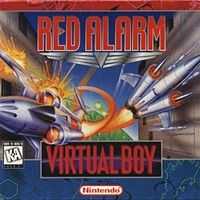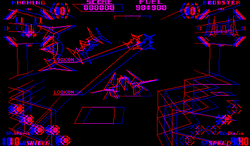Red Alarm
| Red Alarm | |
|---|---|
 | |
| Developer(s) | T&E Soft |
| Publisher(s) | Nintendo |
| Platform(s) | Virtual Boy |
| Release date(s) | |
| Genre(s) | Shoot 'em up |
| Mode(s) | Single-player |
Red Alarm (レッドアラーム Reddo Arāmu) is a 1995 shoot 'em up video game developed by T&E Soft and published by Nintendo. Released as a Virtual Boy launch game, it requires the player to pilot a space fighter and defeat the army of a malevolent artificial intelligence called "KAOS". The game takes inspiration from the 1993 title Star Fox, and it is one of the few third-party releases for the Virtual Boy. Unlike most of the console's games, Red Alarm features three-dimensional (3D) polygonal graphics. However, hardware constraints limited the visuals to bare wire-frame models, similar to those of Battlezone.
Since the time of its release, certain critics have praised Red Alarm as the Virtual Boy's best game. It has received criticism for its unclear visuals.
Gameplay and plot

Red Alarm is a shoot 'em up that takes place in a three-dimensional (3D) graphical environment.[1] It is set during the 21st century, in the aftermath of a 70-year world war that led to the establishment of a utopian society without weapons. An artificially intelligent defense system called "KAOS", which had been used to end the war, becomes sentient and builds an army with which to wipe out humanity. Assuming control of a "Tech-Wing" space fighter, the player seeks to destroy KAOS's forces and finally its mainframe.[2] The game is broken up into six levels,[3] each of which culminates in a boss fight.[4][2]
The player uses the Tech-Wing's laser cannons to attack, and its guided missiles to destroy armored enemies. Shields on the craft offer limited protection from enemy fire; evasion is critical.[2] The Tech-Wing may be maneuvered in any direction,[1] and certain levels contain branching corridors and dead ends that force players to retrace their paths. Four camera angles—three third-person viewpoints and the first-person "cockpit view"—are available.[4] When a level is completed, the player may watch a replay of their performance from multiple perspectives.[2] As a Virtual Boy game, Red Alarm features a red-and-black color palette and stereoscopic 3D visuals,[1][5] the depth of which may be adjusted by the player.[6]
Development


Red Alarm was published by Nintendo and developed by T&E Soft,[7] one of the few third-party companies approached to develop for the Virtual Boy. According to the console's creator, Gunpei Yokoi, Nintendo tried to "maintain as much control as possible" over Virtual Boy game development, so that low-quality releases by outside companies could be avoided.[8] Although T&E Soft was known for golf video games,[3] the design of Red Alarm was inspired by that of Star Fox,[7] a rail shooter for the SNES. This decision was considered by Patrick Kolan of IGN to be "a departure for the team".[3] Unlike many Virtual Boy games, Red Alarm features an engine that displays 3D graphics:[5][9] the game world is rendered in wire-frame polygonal visuals similar to those of Battlezone.[3] Because of the console's limited technology, solid 3D graphics were not viable.[9]
Red Alarm debuted in North America at the 1995 Winter Consumer Electronics Show,[10] and it was confirmed as a launch game for the Virtual Boy at that year's Electronic Entertainment Expo.[11] The console was released alongside Red Alarm and several other titles in 1995,[12] on July 21 in Japan and August 14 in the United States.[13][9]
Reception
| Reception | ||||||||||||||||
|---|---|---|---|---|---|---|---|---|---|---|---|---|---|---|---|---|
| ||||||||||||||||
Electronic Gaming Monthly praised the good controls but complained that the graphics are confusing, making it easy to get lost and difficult to tell what the player ship is approaching. They gave the game an average score of 6.75, summarizing it as "pretty decent".[14] Despite this mixed review, they later awarded it Best Virtual Boy Game of 1995.[20] Next Generation 's reviewer felt that Red Alarm 's elements should add up to "a fantastic game", but that, "in actual practice, none of it really works."[18] The red-and-black color scheme used in the game were said to cause eye strain, headaches, and nausea.[5]
Legacy
An article by ABC Good Game considered Red Alarm to be one of the most graphically impressive games on the Virtual Boy, due to its "proper 3D graphics." The writer considered it one of the console's most entertaining games as well.[5]
See also
References
- ↑ 1.0 1.1 1.2 Mott, Tony (October 1995). "The Games; Red Alarm". Super Play (36): 11.
- ↑ 2.0 2.1 2.2 2.3 Red Alarm Instruction Booklet. Nintendo. August 14, 1995. pp. 8, 9, 13, 20, 21, 24, 30.
- ↑ 3.0 3.1 3.2 3.3 Kolan, Patrick (January 14, 2008). "Virtual Boy's Best Games". IGN. Archived from the original on May 13, 2014.
- ↑ 4.0 4.1 "Red Alarm". Nintendo Power (76): 35–39. September 1995.
- ↑ 5.0 5.1 5.2 5.3 "The Virtual Boy". Australian Broadcasting Corporation. June 1, 2009. Archived from the original on August 21, 2009.
- ↑ Kolan, Patrick (December 14, 2008). "IGN Retro: Virtual Boy Revisited". IGN. Archived from the original on March 13, 2013.
- ↑ 7.0 7.1 "Virtual Boy: Nintendo Names the Day". Next Generation (8): 18. August 1995.
- ↑ "Which Game System is the Best?; Virtual Boy". Next Generation (12): 69–71. December 1995.
- ↑ 9.0 9.1 9.2 McFerran, Damien (May 2009). "Retroinspection: Virtual Boy". Retro Gamer (64): 57–61.
- ↑ "Several Virtual Boy Games Confirmed for U.S. Release". Electronic Gaming Monthly (68): 94, 95. March 1995.
- ↑ "Virtual News; Virtual August". Total! (43): 16, 17. July 1995.
- ↑ Ryan, Jeff (September 2012). Super Mario: How Nintendo Conquered America. Penguin Books. ISBN 978-1591845638.
- ↑ Kohler, Chris (August 13, 2010). "Virtual Boy, Nintendo's Big 3-D Flop, Turns 15". Wired. Archived from the original on July 1, 2014.
- ↑ 14.0 14.1 "Red Alarm". Electronic Gaming Monthly (75): 38. October 1995.
- ↑ "NEW GAMES CROSS REVIEW: レッドアラーム". Weekly Famicom Tsūshin (347): 30. August 1995.
- ↑ Halverson, Dave; Barres, Nicholas (November 1995). "Virtual Boy Viewpoints". GameFan 3 (11): 99.
- ↑ Slo Mo (November 1995). "ProReview; Red Alarm". GamePro (85): 85.
- ↑ 18.0 18.1 "Red Alarm". Next Generation (9): 93. September 1995.
- ↑ Danny (October 1995). "Virtually Here!". Total! (46): 36, 37.
- ↑ "Electronic Gaming Monthly's Buyer's Guide". 1996.
External links
| ||||||||||